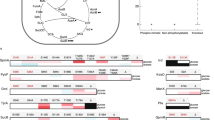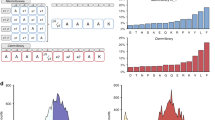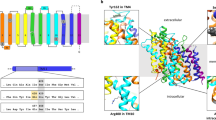Abstract
We report the identification of the mutations in the only known case of L-3-phosphoserine phosphatase deficiency, a recessively inherited condition. The two mutations correspond to the replacement of the semiconserved Asp32 residue by an asparagine and of the extremely conserved Met52 by a threonine. The effects of both mutations were studied on the human recombinant enzyme, expressed in Escherichia coli. Met52Thr almost abolished the enzymatic activity, whereas the Asp32Asn mutation caused a 50% decrease in Vmax. In addition, L-serine, which inhibits the conversion of [14C] phosphoserine to serine when catalysed by the wild-type enzyme, had a lesser inhibitory effect on the Asp32Asn mutant, indicating a reduction in the rate of phosphoenzyme hydrolysis. These modifications in the properties of the enzyme are consistent with the modification in the kinetic properties observed in fibroblasts from the patient.
Similar content being viewed by others
Introduction
The amino acid L-serine is not only a substrate for protein synthesis, but also a precursor for diverse compounds including ‘classical’ amino acids (glycine, L-cysteine, L-selenocysteine), D-serine, a potential neurotransmitter, phospholipids, as well as glycolipids.1,2 It is also a major source of methylenetetrahydrofolate and other one-carbon donors required for the synthesis of purines and thymidine. L-serine, a nonessential amino acid, is synthesized de novo from 3-phosphoglycerate, a glycolytic intermediate. The latter is converted successively to phosphohydroxypyruvate, L-3-phosphoserine and L-serine by 3-phosphoglycerate dehydrogenase, 3-phosphoserine aminotransferase and 3-phosphoserine phosphatase, respectively. L-serine can also be synthesized from glycine.1 In addition to this, L-serine can be derived from degradation of protein and phospholipids, both from endogenous sources and dietary intake.
Two defects in the biosynthesis of L-serine have been described. One, due to 3-phosphoglycerate dehydrogenase deficiency,3,4,5,6 is characterized by low levels of L-serine and glycine in cerebrospinal fluid and variable (low to normal levels) in plasma. Patients with this condition show congenital microcephaly, severe epilepsy that responds to the administration of supplements of L-serine and glycine,7,8 and profound psychomotor retardation. Missense mutations have been reported in the gene encoding 3-phosphoglycerate dehydrogenase.4,6
The other known defect of L-serine deficiency is L-3-phosphoserine phosphatase deficiency.9 This has been described only in one boy with growth and psychomotor retardation, who had lowered levels of L-serine in CSF and plasma. This boy had also facial features suggestive of a Williams’ syndrome, and indeed a submicroscopic 7q11.23 deletion was identified, indicating hemizygosity of the elastin gene.10 The residual phosphoserine phosphatase activity in fibroblasts and lymphoblasts from this patient amounted to about 25% of the control value. However, the kinetic properties of this residual enzymatic activity were distinct from those of the control enzyme, since the inhibition of [14C]L-3-phosphoserine hydrolysis by L-serine was no longer observed. This suggested that at least one of the two alleles corresponded to a missense mutation. As the gene encoding phosphoserine phosphatase was also known to be on chromosome 7,11 the possibility that the microdeletion responsible for the Williams' syndrome had removed the other copy of the phosphoserine phosphatase gene had also to be considered.
The purpose of the present work was to identify the genetic defect responsible for phosphoserine phosphatase deficiency in this case.
Methods
The cDNA encoding phosphoserine phosphatase was PCR-amplified using cDNA from patient lymphoblasts as a template. It was subcloned in pBluescript and sequenced as previously described.12 The mutations found in the cDNA were confirmed by amplification and sequencing of exons 2 and 3 using intronic primers. The mutation search in the controls was done by SSCP and heteroduplex analysis of the same two exons.13,14
Protein expression was performed in E. coli BL21(DE3) pLysS using the pET3a expression system.15 The cells were first grown at 37°C in M9 salts medium complemented with casamino acids (0.1%), biotin (500 μg/l), thiamin (500 μg/l), MgSO4 (1 mM), glucose (10 mM), ampicillin (100 μg/l) and chloramphenicol (25 μg/l) until A600 reached ≈0.5. Isopropylthiogalactoside was then added to a concentration of 0.4 mM and the expression of phosphoserine phosphatase was carried out for 40 h at 20°C, at which time the cells were collected and extracted.12 Purification and assays of phosphoserine phosphatase were carried out as previously described.9,12 For the temperature-inactivation experiment, the purified proteins were incubated in the presence of 20 mM HEPES pH 7.1, 1 mM dithiothreitol, 1 mM EGTA and 0.5 mg/ml bovine serum albumin for 20 min at 40, 45, 50, 55, 60 or 65°C.
Results
Identification of the mutations
The coding region of the L-3-phosphoserine phosphatase cDNA was PCR-amplified using lymphoblast cDNA from the patient. Sequencing allowed the identification of two mutations (Figure 1), G94A and T155C (numbering with respect to the initiator ATG). These led to the replacement of a fairly well-conserved aspartate (Asp32) by an asparagine, and of an extremely conserved methionine (Met52) by a threonine.
Partial alignment of L-3-phosphoserine phosphatases. Part of the human sequence (Hsap; P78330) is aligned with those of Mus musculus (Mmus, NP_598661), Arabidopsis thaliana (Atha, T51362), E. coli (Ecol, NP_757319), Methanococcus jannaschii (Q58989) and Saccharomyces cerevisiae (P42941). The mutated residues are indicated below the alignment. The phosphorylatable aspartate is indicated by an asterisk.
BLAST searches of the human phosphoserine phosphatase cDNA12 with genomic DNA allowed the identification of five exons, matching nucleotides 169–1600. However, no genomic sequence corresponded to the first 168 nucleotides of the cDNA, suggesting that a first, noncoding exon is not yet represented in genomic sequences. This is consistent with the fact that a similar, 6-exon structure, with a first noncoding exon, is observed in the case of the mouse L-3-phosphoserine phosphatase gene. Furthermore, the first 168 nucleotides of the human cDNA12 are found in about 30 EST sequences corresponding to the phosphoserine phosphatase mRNA, thus excluding a cloning artifact. In addition, the first coding exon in the human gene (presumably exon 2) is preceded by a bona fide splicing acceptor site (tttatcttttttcttgtagGA).
PCR amplification of exons 2 and 3 starting from genomic DNA from the patient and his parents confirmed the presence of the two mutations, and indicated that the G94A and T155C mutations were inherited from the father and the mother, respectively. Neither of these two mutations was found in 50 controls.
Effect of the mutations on the enzymatic activity
The effect of the mutations on phosphoserine phosphatase activity was studied by expressing the wild-type and mutated proteins in E. coli BL21(DE3) pLysS using pET3a as an expression vector. Induction of the cells with isopropylthiogalactoside led to the appearance of a protein with the expected size and in similar amounts in all the three cases. The three proteins were purified by DEAE-sepharose chromatography to near-homogeneity. The specific activity of the Asp32Asn (11.5 U/mg protein) and Met52Thr (0.8 U/mg protein) mutants amounted to about 50 and 3% of the wild-type enzyme (24.5 U/mg protein). The Km for phosphoserine of the Asp32Asn mutant was about 2.5-fold higher than that of the wild-type enzyme (5.7 versus 2.2 μ M). Since it was previously found that the residual phosphoserine phosphatase activity present in the patient was not inhibited, but slightly activated by L-serine,9 we tested the effect of this amino acid on the conversion of [14C]phosphoserine to serine. We found indeed that, with the Asp32Asn mutant, a similar behaviour was observed (Figure 2). Of interest is the fact that the rate of the reaction in the presence of a saturating concentration of serine, which corresponds to an exchange reaction,9 is similar for the wild-type enzyme and the Asp32Asn mutant.
We also tested the effect of the Asp32Asn on the stability of phosphoserine phosphatase. Inactivation of the enzyme occurred essentially between 55 and 60°C, in a similar manner as with the control.
Discussion
In the present paper, we report the identification of two mutations in a patient with phosphoserine phosphatase deficiency.9 Each of these two mutations has been transmitted from one parent, indicating that they are allelic. One of them results in the replacement of an extremely conserved methionine by a threonine and almost abolishes the activity, whereas the other replaces a relatively conserved aspartate residue by an asparagine and results in a 50% decrease in Vmax as well as an apparent suppression of the partial inhibition exerted by L-serine when [14C]phosphoserine is used as a substrate. The effect of these two allelic mutations accounts, therefore, for the ≈75% decrease in Vmax observed in cells from the patient, as well as for the loss of inhibition exerted by L-serine when the assay is performed with [14C]phosphoserine.9 We may therefore conclude that these two mutations are responsible for the partial phosphoserine phosphatase deficiency observed in this patient. The finding of two mutations in the phosphoserine phosphatase gene greatly reinforces our previous conclusion that the patient has a deficiency in the biosynthesis of L-serine.
Owing to the localization of the phosphoserine phosphatase gene on chromosome 7, we previously speculated that one of the two mutations could correspond to the loss of one copy of this gene in the microdeletion responsible for the Williams' syndrome observed in the same patient. With the now almost completed sequence of the human genome, it appears that the phosphoserine phosphatase gene and the elastin gene reside on the short arm (7p11; 55.5 Mbp) and the long arm of chromosome 7 (7q11.2; 72.1 Mbp), respectively, and are separated by about 16.5 Mbp. Consequently, there appears to be no link between the two defects, most particularly since the deletion has been reported to be submicroscopic.9
Interpretation of the effect of the two mutations
Structure analysis of Methanococcus jannaschii phosphoserine phosphatase indicates that Met43, which aligns with Met52 in the human enzyme, contacts the substrate in a closed conformation of the protein.16 In the human structures, which are in slightly different open conformations,17,18 Met52 and the surrounding amino acids in the sequence are disordered, presumably allowing phosphoserine to access the catalytic site and the products to leave it. It has been proposed that the extremely conserved methionine is an important factor in switching the enzyme from the open to the closed conformation by interacting with the substrate. The presence of a methionine in this position could indeed stabilize the disordered region and promote refolding to form helix 3 (helix 2 in the M. jannaschii enzyme), which closes the catalytic site.18 This role, and the high conservation of this residue, is consistent with the dramatic effect of the Met52Thr mutation, which almost abolishes the enzymatic activity.
Concerning the effect of the other mutation, it should first be recalled that phosphoserine phosphatase catalyses a two-step reaction. The first one is the transfer of the phosphoryl group of the substrate onto Asp20, with liberation of free L-serine, and the second one consists in the hydrolysis of the phosphoaspartate residue.12,19,20 L-serine, a noncompetitive inhibitor, acts by binding to the phosphoenzyme, thereby preventing its hydrolysis and allowing re-formation of phosphoserine. The production of [14C]serine from [14C]phosphoserine is a measure of substrate hydrolysis in the absence of a significant amount of L-serine, but it corresponds to an exchange reaction between phosphoserine and L-serine in the presence of L-serine at inhibitory concentrations. This exchange reaction results from the succession of the following steps: (1) formation of phosphoenzyme from [14C]phosphoserine and free enzyme; (2) liberation of [14C]serine; (3) binding of nonradioactive serine; (4) transfer of the phosphoryl group with production of nonradioactive phosphoserine. The fact that the overall reaction is decreased with little change in the rate of the exchange reaction points therefore to the slowing down of a step that is specific for the overall hydrolysis reaction, possibly phosphoenzyme hydrolysis or liberation of inorganic phosphate. Asp32 is in the neighbourhood of Glu29, an extremely conserved residue that may indirectly participate in catalysis by forming hydrogen bonds with a water molecule, which itself hydrogen-bonds the water molecule attacking the phosphoenzyme.16 Replacement of Asp32 by an asparagine could therefore favour an interaction of this residue with Glu29, thereby lessening its ability to stabilize the water network involved in phosphoenzyme hydrolysis.
In conclusion, the finding of two allelic mutations in the L-3-phosphoserine phosphatase gene confirms that serine deficiency can be caused by a decrease in the activity of this specific phosphatase. Mutations in the corresponding gene should be searched in patients with low L-serine levels. One of the two identified mutations points to the importance of a conserved methionine in helix 2, which plays a role in closing the catalytic site.
References
Snell K : The duality of pathways for serine biosynthesis is a fallacy. Trends Biochem Sci 1986; 11: 241–243.
Wolosker H, Panizzutti R, De Miranda J : Neurobiology through the looking-glass: D-serine as a new glial-derived transmitter. Neurochem Int 2002; 41: 327–332.
Jaeken J, Detheux M, Van Maldergem L, Carchon H, Foulon M, Van Schaftingen E : 3-phosphoglycerate dehydrogenase deficiency: an inborn error of serine biosynthesis. Arch Dis Child 1996; 74: 542–545.
Klomp LW, de Koning TJ, Malingre HE et al: Molecular characterization of 3-phosphoglycerate dehydrogenase deficiency – a neurometabolic disorder associated with reduced L-serine biosynthesis. Am J Hum Genet 2000; 67: 1389–1399.
Pineda M, Vilaseca MA, Artuch R et al: 3-phosphoglycerate dehydrogenase deficiency in a patient with West syndrome. Dev Med Child Neurol 2000; 42: 629–633.
Pind S, Slominski E, Mauthe J et al: V490M, a common mutation in 3-phosphoglycerate dehydrogenase deficiency, causes enzyme deficiency by decreasing the yield of mature enzyme. J Biol Chem 2002; 277: 7136–7143.
de Koning TJ, Duran M, Dorland L et al: Beneficial effects of L-serine and glycine in the management of seizures in 3-phosphoglycerate dehydrogenase deficiency. Ann Neurol 1998; 44: 261–265.
de Koning TJ, Jaeken J, Pineda M, Van Maldergem L, Poll-The BT, van der Knaap MS : Hypomyelination and reversible white matter attenuation in 3-phosphoglycerate dehydrogenase deficiency. Neuropediatrics 2000; 31: 287–292.
Jaeken J, Detheux M, Fryns JP, Collet JF, Alliet P, Van Schaftingen E : Phosphoserine phosphatase deficiency in a patient with Williams syndrome. J Med Genet 1997; 34: 594–596.
Ewart AK, Morris CA, Atkinson D et al: Hemizygosity at the elastin locus in a developmental disorder, Williams syndrome. Nat Genet 1993; 5: 11–16.
Koch GA, Eddy RL, Haley LL, Byers MG, McAvoy M, Shows TB : Assignment of the phosphoserine phosphatase gene (PSP) to the pter-q22 region of chromosome 7. Cytogenet Cell Genet 1983; 35: 67–69.
Collet JF, Gerin I, Rider MH, Veiga-da-Cunha M, Van Schaftingen E : Human L-3-phosphoserine phosphatase: sequence, expression and evidence for a phosphoenzyme intermediate. FEBS Lett 1997; 408: 281–284.
Orita M, Iwahana H, Kanazawa H, Hayashi K, Sekiya T : Detection of polymorphisms of human DNA by gel electrophoresis as single-strand conformation polymorphisms. Proc Natl Acad Sci USA 1989; 86: 2766–2770.
Nagamine CM, Chan K, Lau YF : A PCR artifact: generation of heteroduplexes. Am J Hum Genet 1989; 45: 337–339.
Studier FW, Moffatt BA : Use of bacteriophage T7 RNA polymerase to direct selective high-level expression of cloned genes. J Mol Biol 1986; 189: 113–130.
Wang W, Kim R, Jancarik J, Yokota H, Kim SH : Crystal structure of phosphoserine phosphatase from Methanococcus jannaschii, a hyperthermophile, at 1.8 A resolution. Structure (Camb) 2001; 9: 65–71.
Kim HY, Heo YS, Kim JH et al: Molecular basis for the local conformational rearrangement of human phosphoserine phosphatase. J Biol Chem 2002; 277: 46651–46658.
Peeraer Y, Rabijns A, Verboven C, Collet JF, Van Schaftingen E, De Ranter C : Acta Crystallogr D 2003; D59: 971–977.
Collet JF, Stroobant V, Pirard M, Delpierre G, Van Schaftingen E : A new class of phosphotransferases phosphorylated on an aspartate residue in an amino-terminal DXDX(T/V) motif. J Biol Chem 1998; 273: 14107–14112.
Collet JF, Stroobant V, Van Schaftingen E : Mechanistic studies of phosphoserine phosphatase, an enzyme related to P-type ATPases. J Biol Chem 1999; 274: 33985–33990.
Acknowledgements
MVDC is Chercheur qualifié and JFC is Chargé de recherche of the Belgian Fonds National de la Recherche Scientifique, and AR postdoctoral fellow of the Fund for Scientific Research-Flanders (Belgium). This work was supported by the Belgian Federal Service for Scientific, Technical and Cultural Affairs and the Fonds National de la Recherche Scientifique (grants to EVS).
Author information
Authors and Affiliations
Corresponding author
Rights and permissions
About this article
Cite this article
Veiga-da-Cunha, M., Collet, JF., Prieur, B. et al. Mutations responsible for 3-phosphoserine phosphatase deficiency. Eur J Hum Genet 12, 163–166 (2004). https://doi.org/10.1038/sj.ejhg.5201083
Received:
Revised:
Accepted:
Published:
Issue Date:
DOI: https://doi.org/10.1038/sj.ejhg.5201083
Keywords
This article is cited by
-
Systemic lipid dysregulation is a risk factor for macular neurodegenerative disease
Scientific Reports (2020)
-
L-serine synthesis via the phosphorylated pathway in humans
Cellular and Molecular Life Sciences (2020)
-
Genome-wide analyses identify common variants associated with macular telangiectasia type 2
Nature Genetics (2017)
-
On the phenotypic spectrum of serine biosynthesis defects
Journal of Inherited Metabolic Disease (2016)
-
Mechanisms of toxicity of triphenyltin chloride (TPTC) determined by a live cell reporter array
Environmental Science and Pollution Research (2013)





